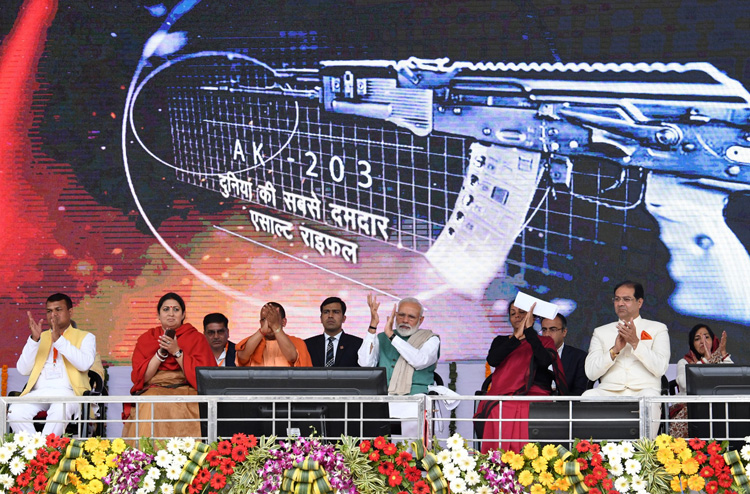INDIAN ARMED FORCES CHIEFS ON OUR RELENTLESS AND FOCUSED PUBLISHING EFFORTS

The insightful articles, inspiring narrations and analytical perspectives presented by the Editorial Team, establish an alluring connect with the reader. My compliments and best wishes to SP Guide Publications.

"Over the past 60 years, the growth of SP Guide Publications has mirrored the rising stature of Indian Navy. Its well-researched and informative magazines on Defence and Aerospace sector have served to shape an educated opinion of our military personnel, policy makers and the public alike. I wish SP's Publication team continued success, fair winds and following seas in all future endeavour!"

Since, its inception in 1964, SP Guide Publications has consistently demonstrated commitment to high-quality journalism in the aerospace and defence sectors, earning a well-deserved reputation as Asia's largest media house in this domain. I wish SP Guide Publications continued success in its pursuit of excellence.
- Operation Sindoor: Resolute yet Restrained
- India’s Operation Sindoor Sends a Clear Message to Terror and the World – ‘ZERO TOLERANCE’
- Japan and India set forth a defence cooperation consultancy framework, talks on tank and jet engines
- Terrorist Attack in Pahalgam in Kashmir: Unfolding a long surgical war against PAK
- Lt General Pratik Sharma takes over Command of Indian Army's Northern Command
Mama Mia - MIA AK-203
 |
The Author is Former Director General of Information Systems and A Special Forces Veteran, Indian Army |

On March 3, 2019, Prime Minister Narendra Modi laid the foundation stone for the AK-203 rifle manufacturing unit in Amethi; Indo-Russia Rifles Limited plant at Ordnance Factory Board (OFB) Korwa in Amethi. Defence Minister Nirmala Sitharaman earlier read out a note from Russian President Vladimir Putin, which said, "The new joint venture will manufacture world famous Kalashnikov assault rifles of the newest 200 series and eventually will reach full localisation of production. Thus, the Indian defence-industrial sector will have the opportunity to fulfill the needs of national security agencies in this category of small arms, resting upon advanced Russian technologies." Prime Minister Modi in turn said, "One of the most advanced rifles in world AK-203 will be made in Amethi. It will be made by a joint-venture of India and Russia. I express my gratitude to my friend President Vladimir Putin. This venture was made possible in such a short time by his support." In his note, Putin had also said, "I am convinced that commissioning of the new enterprise will contribute to stronger defence potential of India, to further advance of the scientific and industrial basis of the national economy, will be instrumental in terms of creating new jobs for qualified work force, and will provide an impetus to professional education and personnel training. The plant itself will become another symbol of friendship and constructive cooperation between our two countries".
The facility is to manufacture 75,000 units of AK-203 assault rifles for the Armed Forces. These rifles with folding butts can be fitted with 40mm under-barrel grenade launcher or a bayonet. It also has a mounting rail for optical, collimator or night sights, while the muzzle brake provides for cyclic fire accuracy and further reduces muzzle climb and burst recoil. After the rifles are supplied to the defence forces, the government, in the next phase, is to provide them to Central Armed Police Forces (CAPF) and state police forces; possibly achieving this over 15-20 years. Initiation of the process to indigenously develop state-of-the-art assault rifle is a welcome step, which will meet the long-standing demand of the Armed Forces, particularly the Army involved in counter-insurgency on a daily basis. It is well known that Kalashnikov was keen to undertake the AK-203 project with the Adani Group but the government was apprehensive because the Rafale controversy had erupted. Adani Group anyway may not have been agreeable to establish the joint venture with Kalashnikov in UP. So, the excuse found was that this being a government-to-government venture, Kalashnikov could only tie up with a government-owned entity.
Addressing his first rally in Amethi since 2014, Modi said, the rifles will be known as "Made in Amethi" (MIA) and will help security forces in militant encounters. This takes defence production in India to a new level of politicisation – a trend that is likely to be continued. But all said and done, there are a number of issues that merit attention.
- Looking back over the decades, a joint venture (JV) between the Original Equipment Manufacturer (OEM) with an Indian company in the private sector is better guarantee for quality and timely supply, latter also because of the lackadaisical working culture and command and control. The Ordnance Factory Board (OFB) with all its ordnance factories has not been able produce a single state-of-the-art small arms category weapon to date.
- Percentage share of OFB in the JV being more than Kalashnikov, the quality and timed delivery will be controlled by the OFB, which doesn't inspire much confidence because of the above mentioned reasons.
- The Amethi unit sure will provide employment to locals under the slogan 'Sab Ka Sath, Sab Ka Vikas', however, this is opposite to valid demands for cutting down the governmental defence-industrial elephant sucking on taxpayers money and providing products to defence forces on inflated prices. The least that could have happened is making corresponding decrease in the Small Arms Factory at Kanpur or elsewhere.
- The quality of indigenous ammunition leaves much to desire including in the small arms segment, which has been pointed out on several occasions. The silenced Uzi's, the Army procured from Israel, remained full silent only till the ammunition too was imported.
- Concurrent to the MIA AK-203 project, MoD is also procuring 72,400 7.62x51mm SIG716 assault rifles from the US, whose ammunition too will be eventually produced in India. The SIG716 uses 7.62mm-51mm cartridge whereas the AK-203 will have 7.62mm-39mm cartridge. This implies two types of ammunition for these rifles in the Army and two types of ammunition required to be produced indigenously. It would be useful to examine these issues, though in all probability these would be glossed over.





